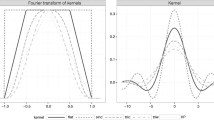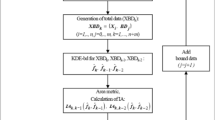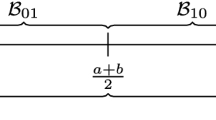Abstract
In this study, a new nonparametric approach using Bernstein copula approximation is proposed to estimate Pickands dependence function. New data points obtained with Bernstein copula approximation serve to estimate the unknown Pickands dependence function. Kernel regression method is then used to derive an intrinsic estimator satisfying the convexity. Some extreme-value copula models are used to measure the performance of the estimator by a comprehensive simulation study. Also, a real-data example is illustrated. The proposed Pickands estimator provides a flexible way to have a better fit and has a better performance than the conventional estimators.








Similar content being viewed by others
References
Aguilera N, Forzani L, Morin P (2011) On uniform consistent estimators for convex regression. J Non-parametr Stat 23(4):897–908
Ahmadabadi A, Ucer Hudaverdi B (2015) Nonparametric estimation for dependence function of some bivariate extreme value copulas with Bernstein polynomials. EMS 2015, European Meeting of Statisticians Amsterdam, July 6–10, Program and Book of Abstracts, pp 90
Barber CB, Dobkin DP, Huhdanpaa HT (1996) The Quickhull algorithm for convex hulls. ACM Trans Math Softw 22(4):469–483
Bücher A, Dette H, Volgushev S (2011) New estimators of the Pickands dependence function and a test for extreme-value dependence. Ann Stat 39:1963–2006
Capera P, Fougeres A-L, Genest C (1997) A nonparametric estimation procedure for bivariate extreme value copulas. Biometrika 84:567–577
Cormier E, Genest C, Nevslehova JG (2014) Using B-splines for nonparametric inference on bivariate extreme-value copulas. Extremes 17:633–659
Deheuvels P (1991) On the limiting behavior of the Pickands estimator for bivariate extreme-value distributions. Stat Probab Lett 12:429–439
Frees EW, Valdez EA (1998) Understanding relationships using copulas. N Am Actuar J 2:1–25
Genest C, Segers J (2009) Rank-based inference for bivariate extreme-value copulas. Ann Stat 37:2990–3022
Gumbel EJ (1960) Distributions des valeurs extremes en plusieurs dimensions. Publ Inst Stat Univ Paris 9:171–173
Hall P, Tajvidi N (2000) Distribution and dependence-function estimation for bivariate extreme-value distributions. Bernoulli 6:835–844
Janssen P, Swanepoel J, Veraverbeke N (2012) Large sample behavior of the Bernstein copula estimator. J Stat Plann Inference 142:1189–1197
Marcon G, Padoan SA, Naveau P, Muliere P (2014) Multivariate nonparametric estimation of the Pickands dependence function using Bernstein polynomials. arXiv preprint arXiv:1405.5228
Nadaraya EA (1964) On estimating regression. Theory Probab Appl 9(1):141–142
Pickands J (1981) Multivariate extreme value distribution. In: Proceedings of the 43rd session of the I.S.I. International Statistical Institute, pp 859–878
Sancetta A, Satchell S (2004) The Bernstein copula and its application to modeling and approximations of multivariate distributions. Econom Theory 3:535–562
Sancetta A (2007) Nonparametric estimation of distributions with given marginals via Bernstein-Kantorovich polynomials: L1 and pointwise convergence theory. J Multivar Anal 98(7):1376–1390
Segers J (2007) Non-parametric inference for bivariate extreme-value copulas. In: Ahsanullah M, Kirmani S (eds) Extreme value distributions. Nova Science, New York, pp 181–203
Sklar A (1959) Fonctions de répartition à n dimensions et leurs marges. Publ Inst Stat Univ Paris 8:229–231
Tawn JA (1988) Bivariate extreme value theory: models and estimation. Biometrika 75:397–415
Watson GS (1964) Smooth regression analysis. Sankhya: Indian J Stat Ser A 26(4):359–372
Author information
Authors and Affiliations
Corresponding author
Rights and permissions
About this article
Cite this article
Ahmadabadi, A., Ucer, B.H. Bivariate nonparametric estimation of the Pickands dependence function using Bernstein copula with kernel regression approach. Comput Stat 32, 1515–1532 (2017). https://doi.org/10.1007/s00180-017-0750-2
Received:
Accepted:
Published:
Issue Date:
DOI: https://doi.org/10.1007/s00180-017-0750-2




